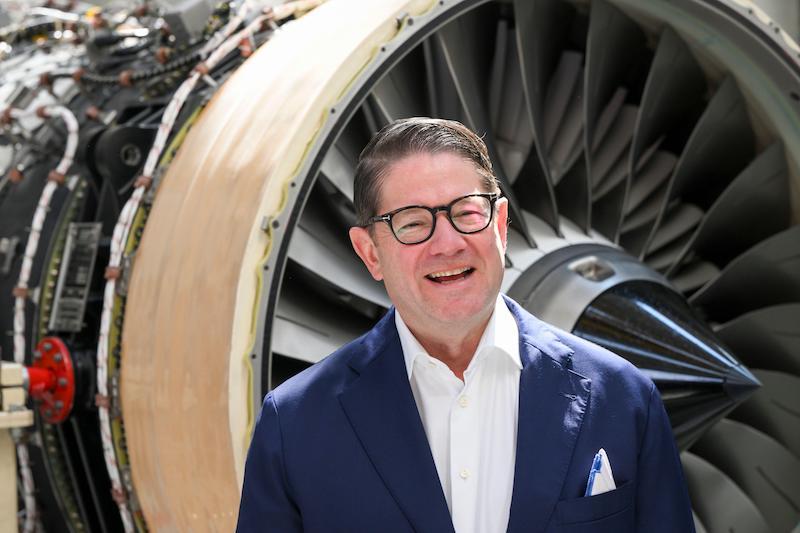
Bombardier's chief executive, Eric Martel.
Eric Martel was named president and CEO of Bombardier in 2020. From 2002-15, Martel held positions at Bombardier as president of Bombardier Business Aircraft; president of Bombardier Aerospace Services; and as vice president and general manager of the Global and Challenger aircraft. Martel rejoined Bombardier after heading up Hydro-Quebec from 2015-20.
How are you finding the market today for Bombardier business jets?
What we’ve observed in late 2021 and for most of 2022 was absolutely phenomenal. There was quite a bit of momentum. This allowed our industry to build quite a bit of backlog, which was amazing. We collectively—and Bombardier most certainly—built on average about two years of backlog. What we’ve been planning for here is to maintain that backlog. If we have a book-to-bill of one, we’re happy. We’ve observed book-to-bill much stronger than that in 2021 and 2022. Because of that, we’re ramping up our production, which we’re investing in right now. So far, things are linking up for meeting our guidance of greater than 138 airplanes. The market today supports a book-to-bill of one. If we’re selling 138 and more airplanes, it means we’re maintaining that two years of backlog. It gives us predictability for the next two years, which is amazing.
How are your fleet operator customers faring?
We have 5,000 [Bombardier] airplanes out there. We have a bunch of them with the fleet operators—NetJets has 189 or 190 of our airplanes; VistaJet with about 170-something; and almost 100 with Flexjet. So, we have a lot of airplanes flying with these guys. If you look at their growth, it’s quite impressive. You’re talking 40%-50% more than 2019. You’re looking at 15% more than last year. These guys are growing by about 15% per year.
What have been the biggest surprises of the last couple of years?
When the pandemic started, we didn’t know where this was going. Remember, we were ourselves in the middle of a restructuring. I think we started to have a signal, right at start of the summer of 2020—with the months of July and August being record sales for some of the fleet operators—calming down everybody at the time. Because I think everybody was nervous. If you go back to second quarter (Q2) 2020, we sat down on the [Q2 financial] call and said we thought there could be an acceleration—and it did happen. I would say the supply chain crisis was probably more major than anticipated, and it’s lasting long. We’ve fixed the logistics issue—I think this part is behind us, but we still have some issues with the supply chain that remain.
What are you anticipating at NBAA this year?
We’re excited. We’re going to show up with most of our products. We’re going to have a Global 7500 and 6500; a Challenger 3500; and also a Challenger 650. Plus, we’re going to have one of our CPO airplanes—a certified pre-owned program airplane. We going to put everything in front of them so that they can see our beautiful airplanes.
How do you see business aircraft technology evolving until 2035?
Right now, we’re spending most of our R&D money on our EcoJet product. There’s the wing and fuselage blending that you’ve been able to see. We have a demonstrator right now—a drone—with 16 ft. of wingspan flying secretly in Canada so that we can test the results. We’re also testing on this vehicle more electrical capabilities. We’re going to get a lot of results. We’re already getting some results. I think this is going to pave the way for when we launch another program, depending on when some of that technology will go on. I think most of the new technology today is driven by this objective that we all have together in reducing emissions. The shape of the airplane is definitely one contributor. Of course, we’re working with the engine guys to continue to reduce their footprint. This is where we’re spending our money right now.
Given the slow ramp-up in SAF production, and the fact that several industries compete for such fuels, is it reasonable for bizav to bet on heavily using SAF in the future?
I think it is. I remain optimistic. We found a creative way ourselves to perform all our flights using about 30% SAF with a book-to-claim system. The distribution is not supporting what it needs to be, but I think we have some smart people that came up with an idea working with some partners to say: 'We’re going to be flying the airplane with regular fuel, but we’re going to pay for the difference and somebody is going to fuel SAF near the production plant, mainly in California, where they can produce it.' I think [with] the demand being there, the distribution will follow.
